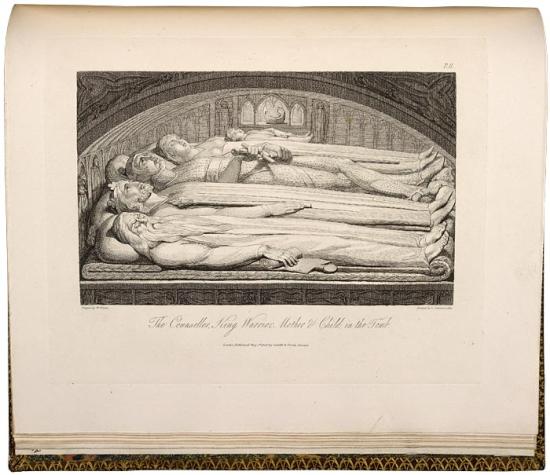The Grave: A Poem

The Grave: A Poem.
London: Printed by T. Bensley for R. H. Cromek . . . , 1808.
Plate 4 (of 12).
The Counsellor, King, Warrior, Mother, and Child.
Inscribed below, Drawn by W. Blake Etched by L. Schiavonetti
London: Published May 1st 1808 by Cadell & Davis. Strand.
Bequest of Julia P. Wightman, 1994
Poems featuring a narrator's melancholy musings on the nature of mortality were very popular during the eighteenth century. A prominent example of the Graveyard genre, Blair's poem, although published in 1743, had never appeared in a special edition. As the inaugural project of R. H. Cromek, an engraver turned publisher, it became a disaster for Blake. Although he created the drawings, Cromek paid him poorly and hired Louis Schiavonetti to engrave them. The loss of the engraving fees and the book's poor reception deprived Blake of new work and initiated several years of penury.
William Blake (1757–1827) occupies a unique place in the history of Western art. His creativity included both the visual and literary arts. In his lifetime he was best known as an engraver; now he is also recognized for his innovative poetry, printmaking, and painting. Blake's keen perception of the political and social climate found expression throughout his work. His strong sense of independence is evident in the complex mythology that he constructed in response to the age of revolution.
Blake was already recognized as an engraver at age twenty-five, when his first volume of poems appeared. At thirty-three, in The Marriage of Heaven and Hell, he audaciously claimed that his birth had marked the origin of a "new heaven" in which his own art would exemplify the creativity prefigured by Milton and Michelangelo. By that time, Blake, in one of his most productive periods, had already produced Songs of Innocence and was at work on a series of illuminated books. In 1818 he met John Linnell, a young painter and engraver, through whom a group of young artists became Blake's followers. Calling themselves the Ancients, they helped perpetuate Blake's influence for generations.
The Morgan's Blake collection—one of this country's most distinguished—began with purchases as early as 1899 by Pierpont Morgan. During the tenure of Charles Ryskamp, director from 1969 to 1986, major gifts almost doubled the size of its Blake holdings. In recent years Ryskamp's own gifts of engravings, letters, and related materials have significantly enriched its scholarly resources.
This online exhibition is presented in conjunction with the exhibition William Blake's World: "A New Heaven Is Begun" on view September 11, 2009, through January 3, 2010.
This exhibition is made possible through the generosity of Fay and Geoffrey Elliott.